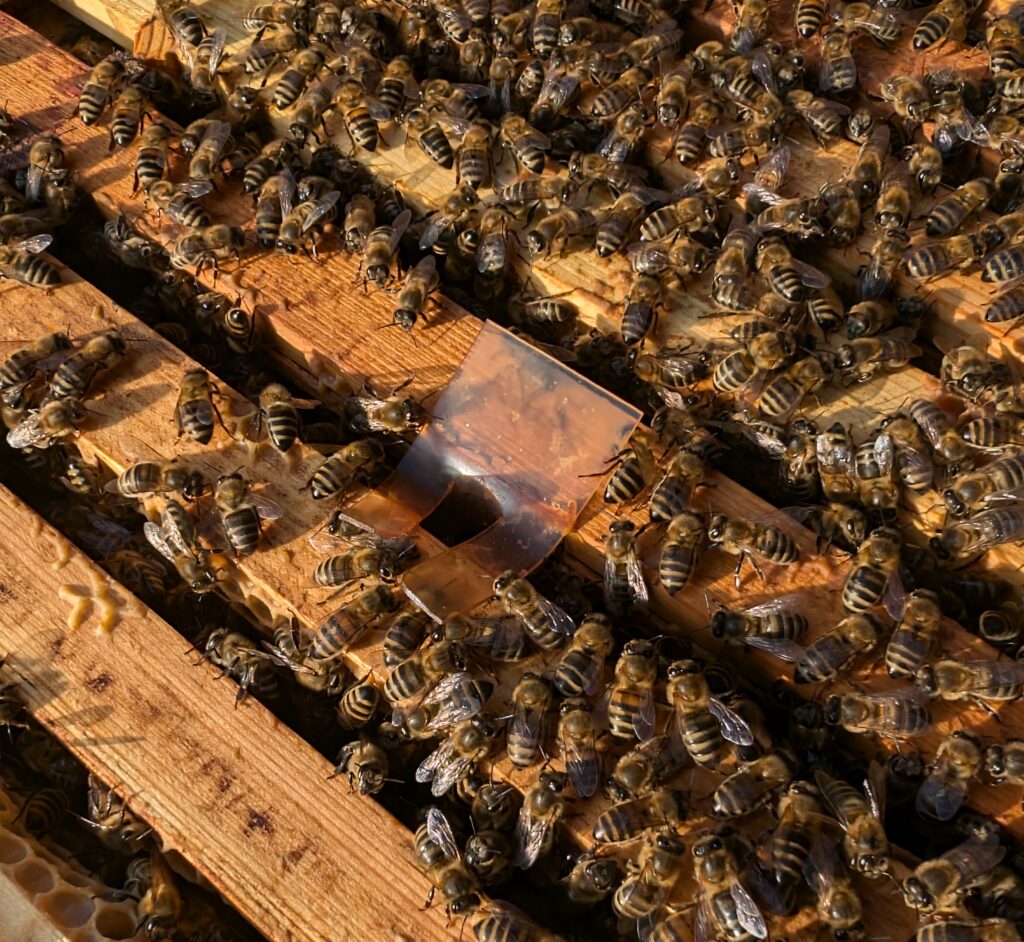In April, Matt expanded his apiary from two colonies to four. It was an exciting time for Matt because he loves beekeeping and it was an exciting time for anyone like me who has tasted Actual Honey! Expanding to four or five colonies was Matt’s goal for this year, so it made me really happy to see my awesome friend fulfilling his ambitions.
In May, Matt exceeded his goals and the Actual Honey empire is up to seven colonies! Let’s find out how this happened…
It actually began with the gentle colony Matt recently purchased. They were a small family with a roomy hive, yet they showed signs of preparing to swarm. Matt was really surprised by this! As knowledgeable as people have become about bees, there are moments that prove we don’t know everything. Despite not understanding it, Matt had to respond to their behaviour, so he split the colony using Pagden’s artificial swarm method.
That makes 5 colonies.
One of Matt’s original two colonies was split in April. In May, he split the other. This was considerably less surprising! The hive had become a beast to accommodate the colony’s numbers. With double brood boxes and four supers, it towered so high it reached Matt’s shoulders and he’s 6’2″! It was no shock when Matt noticed the signs of an impending swarm, so half the colony moved into a fresh new hive.
Actual Honey is up to 6 colonies!
In the past couple of months, all three colonies have been split and one swarm escaped Matt’s apiary. Where did colony number seven come from?!
Matt received a frantic message from a beekeeping friend saying that one of her colonies was swarming. She had no kit and wondered whether Matt did. It just so happened that Matt was thoroughly kitted out! He had stocked up on all the beekeeping gear you can imagine because he wanted to be ready for anything. Experience has taught him that bee drama can occur at any moment and he wanted to be as prepared as possible. So, when his friend asked whether Matt would like to capture the swarm to add to his apiary, he was able to say “Yes, please!”.
We’re up to the full 7 colonies!
With so many additions to his apiary, Matt was starting to find it difficult to keep track of which colony is which, so he added letter tags to each hive. Let’s help him to keep it clear in his mind. It’s time to meet the bees!
| Hive A | Family 1 | Matt purchased this colony in 2022 as part of the Beginner Beekeeping Course he took through Harrogate & Ripon Beekeepers Association. His beekeeping journey begins! |
| Hive B | Family 1 | In 2023, Matt split colony A but tragically those in Hive B perished. To this day, he isn’t sure what happened to them but the memory of discovering his colony dead still makes him sad. In 2024, colony A had grown so much they decided to swarm, but Matt managed to capture them and they became the new Hive B! Read the full story of Matt’s first swarm here. |
| Hive C | Family 2 | In 2025, Matt purchased a family of bees from a beekeeper who developed a bee sting allergy. |
| Hive D | Family 2 | The bees in Hive C quickly showed signs of being ready to swarm, so Matt spilt the colony to form Hive D. |
| Hive E | Family 1 | Hive E was established in 2025 when the bees in Hive B outgrew their home and needed to be split. |
| Hive F | Family 1 | In 2025, Hive A was once again split and the bees took up residence in Hive F. |
| Hive G | Family 3 | Hive G is a colony of new bees that Matt caught when a beekeeping friend’s bees swarmed in 2025. |
Throughout May, Matt went to check on his bustling apiary to see how his numerous colonies were getting on.
Colony 7 a.k.a. Hive G was initially residing in a nuc box, which is a miniature hive for small – or nucleus – colonies. The swarm he caught was made up of three sizeable clusters, so Matt knew they’d be ready for a full-sized hive in no time. After only seven days in the nuc box, they had built honeycomb on every frame Matt had given them and were beginning to fill it up with stores. They grow up so fast, don’t they? It was already time for them to move house, so they now have their very own hive. There is only one task remaining for them to fully establish themselves: Since they began with a virgin queen, she is yet to start laying, but Matt is watching out for the signs.
Matt also wanted to check on the queens of the three colonies that were recently split from three of his other colonies:
- It appeared that one of them hadn’t managed to requeen successfully, so Matt gave them some swarm cells from another hive with developing queens inside.
- One showed evidence of the presence of a virgin queen. Matt didn’t see her, so he thinks she was probably out searching for boyfriends!
- The last had an exquisite dark queen who looked very well mated.
At his next visit, Matt discovered he was mistaken about the unsuccessful requeening. The swarm cells he’d added were torn up and had gaping holes in the sides. That can only mean the reigning queen took action to destroy anyone who may grow up to challenge her authority, kind of like King Herod! Rather than using weapons like Herod’s men, the queen’s workers come to the destroyed cells and cannibalise the infants! As well as getting to witness that atrocity in action, Matt finally spotted the ruthless royal.
There was a lot to celebrate in May but, amongst all the joy, Matt had a serious scare when he noticed something unusual within the colony he’d purchased in April (Hive C). This colony had just received a clean bill of health from an inspector so Matt did not isolate them. However, Matt soon noticed an abnormality in one of the queen cells that he feared could be European Foulbrood, which is a bacterial disease that kills larvae. He contacted a bee inspector. The inspector concluded that it was not European Foulbrood but the less serious Black Queen Cell Virus.
Unfortunately, it is one of the least researched and understood viral diseases that affects honey bees. It seems that Black Queen Cell Virus can be carried almost asymptomatically and have little effect on a colony, or it can be a severe threat that may kill queen larvae, reduce the lifespan of adult bees, and cause the current queen to produce babies who do not survive. Black Queen Cell Virus gets its name through the process of the queen pupae dying, in which she turns from white to yellow to black.
It is believed to be introduced alongside Nosema, which is an illness that gives honey bees upset tummies, but it may also be transmitted by varroa mites. The virus remains active for up to four weeks on more or less any substance, such as pollen, water and honey. This means the colony’s food stores are quickly infected and then nurse bees inadvertently feed contaminated food to brood. The queen may also be laying infected eggs. Additionally, the virus can be spread by beekeeping equipment. That means the virus can easily spread not only throughout the colony, but also to any hive where workers visit the same plants and water sources, or to any hive that has the same beekeeper.
There is no treatment to cure a colony of Black Queen Cell Virus, so beekeepers must isolate the affected colony and sanitise sanitise sanitise until they are certain the virus has been eliminated.
This all sounds rather scary but Black Queen Cell Virus is considered manageable, so I’m sure Matt’s bees will recover.
When the time is right, Matt plans to move some of his hives to a brand new apiary site. His current apiary is suited to housing six hives at most, so this move is much needed.
This new site is at Windmill Hill with Make It Wild! It’s a wonderful arrangement because the land is dedicated to nature above all, which means the bees will have a varied and healthy diet and, in return, the bees will do their part to make sure the plants on this land thrive. I’m thrilled that Matt has managed to secure space for ten hives in this location. He’s already been there to set up his trusty paving slabs and is looking forward to taking his colonies to their lush new home.

